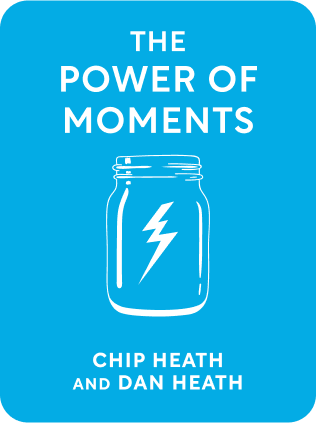

This article is an excerpt from the Shortform book guide to "The Power of Moments" by Chip Heath and Dan Heath. Shortform has the world's best summaries and analyses of books you should be reading.
Like this article? Sign up for a free trial here .
Can you think of a defining moment from your past? What made it so? More generally, what makes a defining moment?
There’s a common misconception that defining moments in life are large milestone events—such as the birth of your child—or simply happen as a matter of pure serendipity—such as going to a café and bumping into the woman you’ll marry. However, according to Chip and Dan Heath, the authors of The Power of Moments, most defining moments happen in small, everyday events, and what makes them stand out is how you shape them by investing your time, effort, and strategic thought.
In this article, we’ll look at three situations where opportunities to create defining moments often come up naturally.
3 Common Situations for Defining Moments
What we know about the psychology of memory suggests three naturally occurring situations with defining moment potential: transitions, milestones, and negative pits.
Situation 1: Transitions
Many large transitions, like your bar mitzvah or college graduation, are natural defining moments in life: They clearly mark a shift from one stage of your life to another in a memorable and meaningful way. However, many people don’t realize how many small transitions happen around us every day—many of which can be made just as memorable and meaningful as the large, obvious ones.
When everyday transitions aren’t marked off by a clear moment, they blend into the flat “sameness” of life, becoming forgettable and meaningless. In some cases, these unmarked transitions—and the lack of clear division between the way things were and the way things are—can cause anxiety. Transitions have the potential to become memorable and meaningful when you engineer a clear moment that carries you from one stage to the next.
Example: Moving On After a Pet’s Passing
After losing your beloved dog Rocky, you struggle to find a new dog to adopt. Eventually, you realize you’re still deeply attached to Rocky and are looking for an exact replacement for him so it feels like he never left.
To help you let go of this attachment, your partner sets up a small ceremony at Rocky’s favorite dog park. You set up a toy box filled with his old toys. Then, you affix a small plaque commemorating Rocky to the bench you two always shared—it helps you have a place where you can continue to feel close to him. After the ceremony, you start the paperwork to adopt a dog you visited a few weeks ago. The ceremony helped you mark the transition from your life with Rocky to your life with a new dog.
| What Types of Transitions Need “Shape”? Transitions often fall under four categories—expected, unexpected, unrealized, and gradual—and they can be large, emotional events or small, personal events. Added shape can be useful for any of these transition types. Expected: These types of transitions are planned out and relatively predictable—often, they’re experiences that most people can relate to. For example, a personal, expected transition may happen when you change jobs and need to transition from an old way of thinking to a new way. For this experience, you can add shape by putting together a personal celebration or two when you make the transition between roles, as Michael D. Watkins suggests in The First 90 Days. You might purchase a new suit or organize a lunch with your new team members where you’ll talk about your new role and get to know them better. Unexpected: These types of transitions happen at unpredictable times and often aren’t aligned with the experiences of those around you. For example, an emotional, unexpected transition may happen when you receive a diagnosis of a life-threatening illness. When Professor Randy Pausch received his terminal pancreatic cancer diagnosis, he added shape to the unexpected transition by creating The Last Lecture to talk about his life experiences and lessons. This lecture was a way to mark the end of his life, say goodbye to friends and colleagues, and give his family a lasting memoir of his love. Unrealized: “Unrealized” transitions are those that we expect will happen, but ultimately don’t come to pass. An unrealized transition might look like expecting to graduate college and then dropping out, or expecting to get married but never doing so. You can add shape to these types of transitions by creating an event that gives closure—for example, you might stage an “undiploma ceremony” to close the college chapter of your life and become more fully engaged in the path your life has taken instead of ruminating on “what could have been.” Gradual: The gradual transition refers to progress that happens slowly over time—the person going through a gradual transition often isn’t aware it’s happening. This can look like developing a friendship or learning a new skill. (We’ll explore ways to add shape to progress in Chapters 7-9.) |
Situation 2: Milestones
Milestones are life events that are acknowledged and feel significant, but are largely arbitrary—for example, turning 30 doesn’t change your life in any significant way, but it feels like an important event all the same. Like transitions, bigger milestones—such as your 21st birthday, retirement, or the purchase of your first home—are more celebrated and therefore more memorable. However, you can easily make small, often-unnoticed milestones into memorable positive spikes with a bit of attention and effort.
| How “Adulting” Helps Create Milestones In The Defining Decade, Meg Jay urges young adults to seek out and celebrate milestones to develop their confidence and pride in themselves—factors that positively affect the way the rest of their lives play out. One way we can see young adults, especially millennials, seeking out milestones to celebrate is in the way they’ve latched onto celebrating instances of “adulting,” or acting in an adult manner—for example, buying a car, doing their own taxes for the first time, or going shopping for a new couch. Some people scoff at this practice of celebrating mundane, obligatory activities and label it another way for millennials to make themselves feel “special.” However, the Heaths’ ideas support young adults’ efforts to find meaning in these novel—though mundane—activities and see them as small milestones along their path to adulthood. |
Example: Celebrating an Employee’s 100th Day
As an example of how to highlight an often-unnoticed milestone, imagine you’ve started a new job. After about three months of working there, you walk into your office to find your cubicle decorated with a banner that reads, “Happy 100 Days!” and a bowl of your favorite candy sitting on your desk. You check your work calendar and see that you have two hours blocked off for a “special lunch event,” during which the organization’s president takes you out for a nice lunch, and you spend a few hours getting to know each other. In the afternoon, your boss stops by to drop off a company “swag bag” that includes a nice jacket, water bottle, and mug branded with the company logo.
An employee’s 100th day working for a company has great potential to be a defining moment, but most organizations don’t think to invest in it and let the day pass by just like any other. If you spot the event’s potential and invest time and effort into making it special for the employee, you’ll create a defining moment that will stand out when they look back on their career with you and will increase their satisfaction and loyalty.
Situation 3: Negative Pits
Recall that negative pits are the emotional lows of an experience—without any intervention, these are the moments someone will remember about an experience when they reflect on it. The Heaths observe that most people react to a negative pit by trying to find a way to fix it and lessen the negative emotions of it. For example, clients hate being on hold, so many companies will play music or trivia to fill the wait time. By fixing the negative pit of being on hold with an entertaining distraction, these companies help ensure that the long wait time isn’t what the client recalls most vividly about her experience.
The Heaths explain that hard moments can actually become positive defining moments when you go beyond simply repairing them—and instead, find a way to turn them into positive peaks to look back on fondly. There are two ways you might do this:
1) Create an unexpected positive experience in response to the pit. Take the pet supply company Chewy as an example: If you inform them that your pet has passed away, they cancel your food delivery subscription immediately. This is the response you expect of them. However, they then go above and beyond expectation to fill in your negative pit with something positive—they send you flowers and a handwritten sympathy card signed by the Chewy team. In this way, they create a positive defining moment that will stand out in your memory when you recall your experience with their brand.
2) Put together a plan of action in response to the negative pit. The Heaths attest that the most memorable—but most uncommon—way to fix a negative pit is to make a perceptible effort to fix it. In many cases, acknowledging a problem, coming up with a plan, and demonstrating a willingness to make things right can make people think of the experience as overall positive.
- For example, a car rental company finds that they don’t get very high customer satisfaction ratings when everything goes perfectly. Rather, their highest ratings come from instances of booking mix-ups and car breakdowns because these situations allow them to demonstrate an effort to work with the client and remedy the problem as quickly as possible. Though something went wrong, the company’s response creates a positive defining moment for their client. Instead of recalling the negative moment, she recalls their swift plan of action and willingness to do everything possible to fix the mistake.
Remember That Investment-Worthy Opportunities Are Everywhere
The Heaths urge you to remember that, while many opportunities for defining moments naturally crop up during transitions, milestones, and negative pits, not all opportunities for defining moments fall neatly into these three categories. Look at all experiences as potential defining moments, because any moment can be made more meaningful and memorable with attention, forethought, and effort.
In other words, not many moments are “engineered” from the very beginning. Most important moments in your life unfold naturally and spontaneously—and these small moments are happening all around you, every day. It’s not engineering experiences from the beginning that’s important. What’s important is your ability to see the extraordinary potential of small, spontaneous moments and your willingness to put in the effort to build them into defining, meaningful moments that matter.
(Shortform note: Several negative reviews of The Power of Moments questioned whether defining moments can ever feel “real” if they’re so carefully engineered. This criticism misses a central idea of the Heaths’ argument—defining moments already exist and therefore are genuine. “Engineering” moments doesn’t mean staging a false event—it simply means giving attention and effort to important events that might otherwise go undetected.)

———End of Preview———
Like what you just read? Read the rest of the world's best book summary and analysis of Chip Heath and Dan Heath's "The Power of Moments" at Shortform .
Here's what you'll find in our full The Power of Moments summary :
- How to make everyday experiences meaningful and memorable
- A look at the four elements that create meaning
- How your senses can play a role in elevating everyday moments






